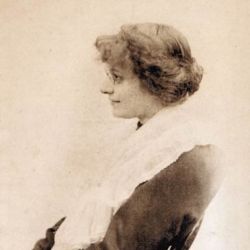
Eleanor Farjeon
Eleanor Farjeon was born in London on 13th February 1881, the third child of writer Benjamin Farjeon and his wife Margaret (Maggie) Jefferson, who was the daughter of the American actor Joseph Jefferson. Just a few months after Eleanor’s birth, in the summer of 1881, her older brother Charles died, aged just one. Eleanor, known to her family as Nellie, remained especially close to her oldest brother, Harry, even after the arrival of two more brothers, Joe in 1883 and Herbert four years later.
By the age of six, Eleanor had already begun writing and her father would advise her on every aspect of the art, encouraging her as she learned. Shortly before her eighth birthday, however, it was discovered that Eleanor’s eyesight was extremely poor. A pair of spectacles were provided and upon wearing them, Eleanor was most surprised to discover that there were patterns on the wallpaper! Her father scoured bookshops for books with larger print and, if this proved impossible, he would read aloud to her himself, determined that her love of literature would not be spoiled by her impaired vision.
Eleanor was educated entirely at home by governesses, while her brothers attended local day schools and she was devastated when Harry left home to attend the Royal Academy of Music in 1894. During their childhood the Farjeons often attended the theatre – an atmosphere which charmed Eleanor and, due to their parents’ connections, they would often be invited backstage to meet the performers, such as Henry Irving, Helen Terry and Sarah Bernhardt.
In 1898, Eleanor’s father became ill. He was able to continue with his writing for the next few years, but the family’s finances were affected. In July 1903, Benjamin died, leaving the family not only inconsolable, but also suffering economically. They moved to a smaller house and sold some books and furniture to make ends meet. Initially, Harry was the only wage-earner in the house, in his position as Professor of Harmony at the Royal Academy of Music. Herbert went on to become a lyricist and writer, while Joe wrote plays and novels. Eleanor also wrote stories and poems, many of which reflected her ideals of love, loyalty and romance – sentiments which she always tempered with practicality.
In November 1912, Eleanor met Edward Thomas and a close friendship was formed almost immediately. For Eleanor, this friendship blossomed into love, but she remained silent about her feelings, knowing that Edward was married with three children. She believed that if she revealed her love, Thomas would feel duty bound to end their friendship and, besides, it was not in her nature to wilfully hurt another person. She encouraged Thomas in his writing and, in January 1915, she began typing out his poems in preparation for sending them off to potential publishers.
When Thomas enlisted in the Artists’ Rifles in July 1915, Eleanor sensed that he had ended his own torment and was happy with his decision. She spent a few days with the Thomas family prior to his departure for France in January 1917. Although Eleanor knew that her own behaviour throughout had been irreproachable, she also deeply regretted the fact that Thomas was leaving, unaware of her true feelings for him.
On 9th April 1917, Thomas was killed. Despite her own devastation, Eleanor responded immediately to his widow, Helen’s request that she should join the Thomas family at their Hampshire home. Eleanor was able to offer comfort to the grieving Helen and practical support around the house and with the children. In later years, Eleanor made no secret of her love for Edward Thomas but, to him, it remained forever unconfessed and unrequited.
After the war, Eleanor became involved with an English teacher named George Earle. Again, when they first met, he was married and Eleanor kept her feelings to herself. However, once his marriage broke down, she felt free to declare her love for him. They were never married but shared a close and lasting relationship until his death in November 1949. By this time, two of Eleanor’s brothers had also died: Herbert in 1945 and her beloved Harry three years later.
Following Earle’s death, Eleanor threw herself into the production of her play, The Silver Curlew, which was being produced by The Arts Theatre. While there, she met the actor Denys Blakelock and the two formed a friendship which would end only with Eleanor’s death.
Eleanor continued to write, her books mainly aimed at children and in 1955 her story, The Little Bookroom, won the Hans Andersen Award and The Carnegie Medal. Her inspiration was her own happy childhood and her fond memories of nursery games with Harry. Later in the same year, Joe also died and in losing this last link with childhood, Eleanor turned more and more to her faith in God and her friendship with Blakelock.
She remained active and continued writing until she was 84 years old, when ill health forced her to give up. One of the last things she wrote before her death on 5th June 1965, was the foreword to a new collection of Edward Thomas’s poems. Among her many literary achievements, Eleanor also wrote the words to the hymn Morning Has Broken and the Children’s Book Circle created the Eleanor Farjeon Award in her memory.
Eleanor’s remembrances of her happy childhood and loving family, her ideals of love and romance are written down for everyone to read and enjoy. As a person, she was full of joy, understanding, tolerance and compassion, with a unique ability to enhance the lives of everyone she met.
Sources:
Scars Upon My Heart by Catherine Reilly
Portrait of a Family by Eleanor Farjeon
Portrait of a Farjeon by Denys Blakelock